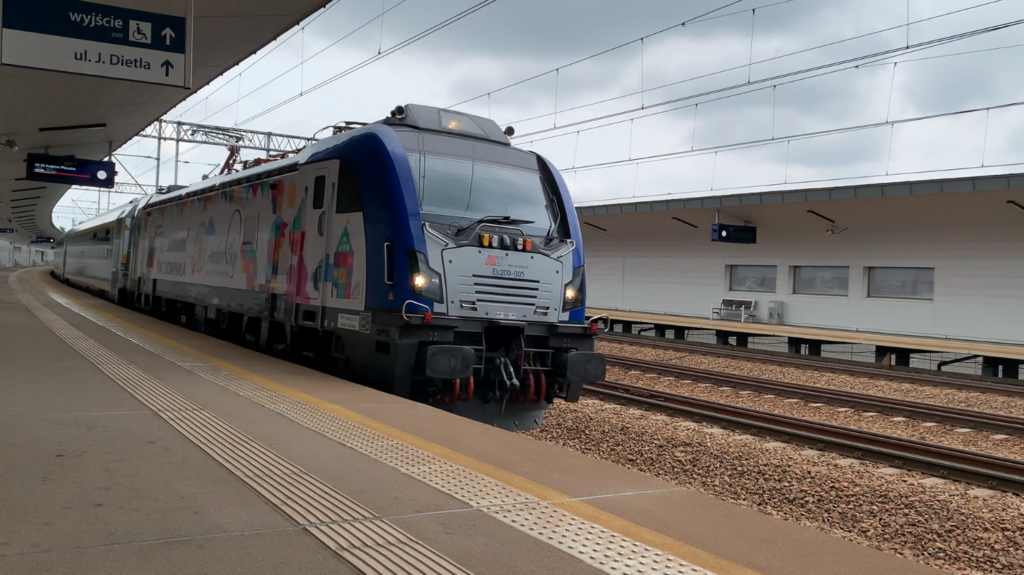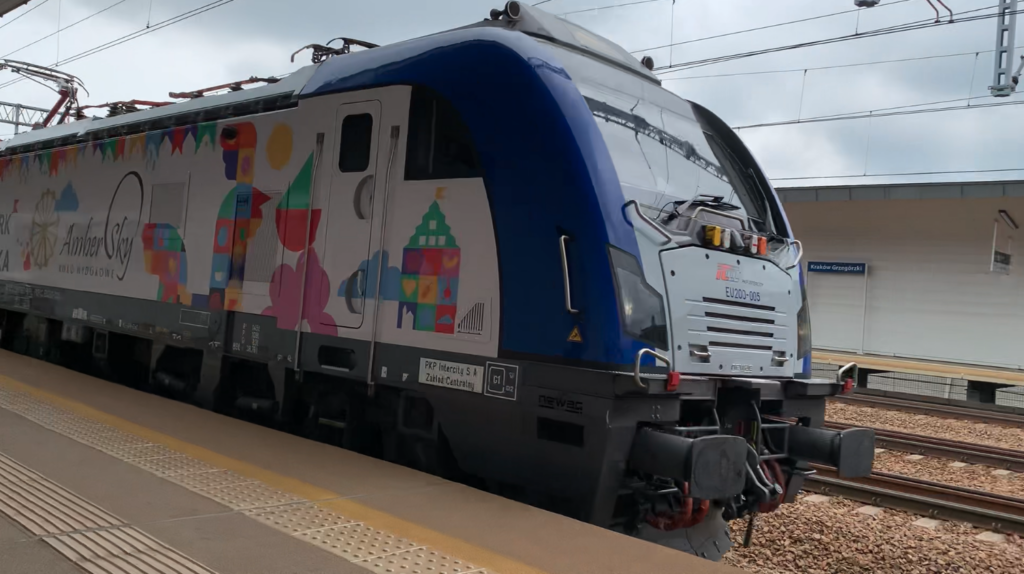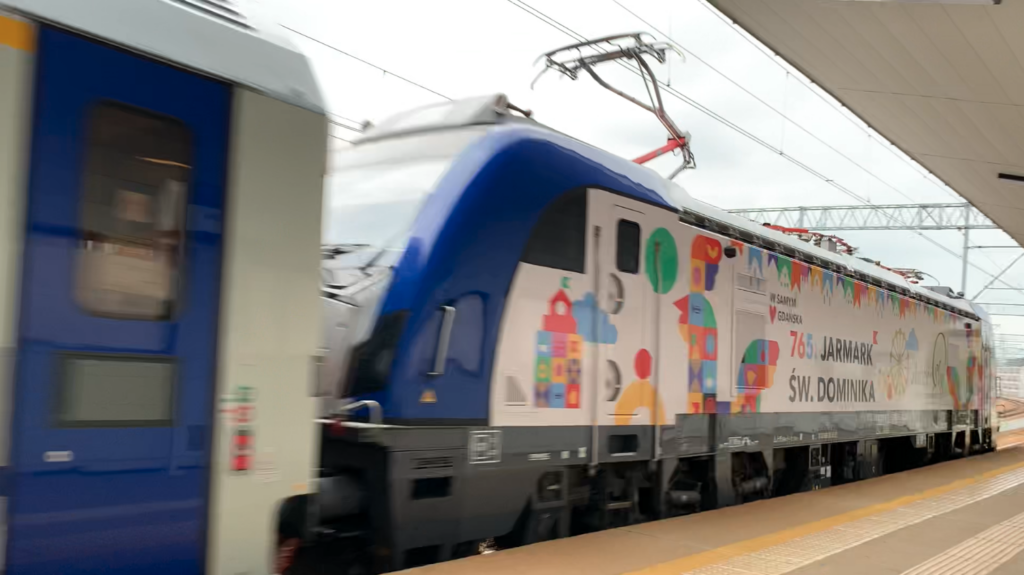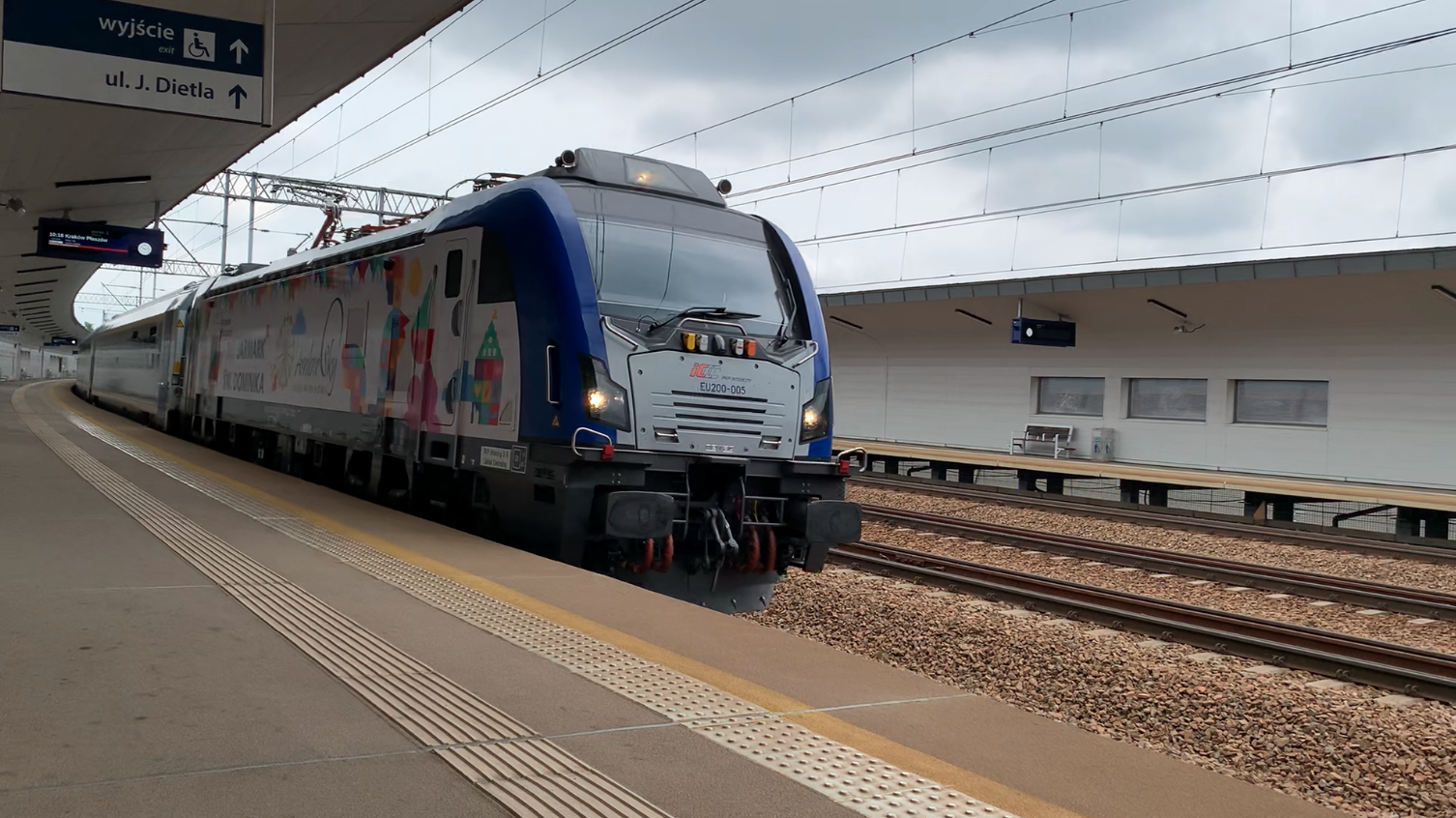Kraków 2025-07-29
Passenger cars with a speed of 200 km/h.




In 2024, after the introduction of Newag EU200 Griffin locomotives to PKP InterCity, operating a classic wagon train at 200 km/h became a reality.
On the night of October 19-20, 2023, the Polish electric locomotive reached a speed of 240 km/h. The Newag Griffin E4MSUa-001 locomotive reached a speed of 240 km/h on the test track, although the locomotive is expected to be certified for a cruising speed of 200 km/h. The locomotive is multi-system, meaning it can be powered by voltages of 3kV DC, 15kV AC, and 25kV AC. This will allow the locomotive to pull trains in the Czech Republic, Slovakia, Austria, Hungary, and Germany. At the end of September 2023, testing of the new Newag Griffin E4MSUa-001 locomotive began on the Central Railway Line, near Góra Włodawska. Achieving a speed of 240 km/h was one of the certification criteria. Currently, only ED250 “Pendolino” electric multiple units operate at this speed on a daily basis in Poland. NEWAG, based in Nowy Sącz, is a Polish manufacturer of modern electric, hybrid, and diesel locomotives (multi-system), EMUs, DMUs, HZTs, and passenger cars. On October 22, 2021, the Polish rail operator PKP InterCity signed a contract for the delivery of 10 multi-system locomotives with an option for 5 additional vehicles, which was exercised in June 2023. On January 10, 2024, a contract was signed for 63 multi-system locomotives with a maximum speed of 200 km/h, with an option for 32 additional locomotives.
As a reminder, NEWAG has previously built EU160 electric locomotives, which were capable of operating at 200 km/h. The problem is that no Polish carrier has placed an order for locomotives capable of operating at 200 km/h. Orders were placed for locomotives capable of 160 km/h (100 mph), which were built and certified for this speed. The EU160 locomotive performs very well on the tracks.
The Newag EU200 locomotive underwent testing in September 2023 on the test track in Żmigród. Work on the Griffin E4MSUa (EU200) locomotive was extended by one month, to 19 months, because the brake discs needed to be replaced to meet the requirements.
The first locomotive certified for 200 km/h and delivered to PKP InterCity was the NEWAG EU200-006. The total contract for 15 EU200 locomotives was worth PLN 388 million. On September 23, 2024, the NEWAG EU200-006 locomotive operated the first passenger train, IC 1510/1 “Słowiniec,” on the Warszawa Zachodnia – Gdynia Główna route. By September 26, 2024, InterCity already had nine EU200 locomotives. All of these locomotives had been in service since September 26, 2024. The introduction of the EU200 locomotives enabled efficient use of the modernized railway routes: the Central Main Line (CMK) and Warsaw-Gdynia. The locomotive’s multi-system capability allows it to be used internationally.
All locomotives are equipped with the European ETCS Level 2 control system, which significantly improves track safety standards. A word of caution: We await the time when, after railway tragedies, not only ordinary railway workers, people who work hard and responsibly, will be in the dock, but also directors and ministers.
The EU200 locomotives also feature a remote diagnostics system, enabling real-time monitoring of locomotive performance. Currently (November 2024), the Griffin ET200 locomotives are also expected to be approved for operation on international routes. First, manufacturer NEWAG is seeking approval for rail networks in the Czech Republic and Slovakia. Next, approval should be granted in countries such as Hungary, Austria, and Germany. Approval should be completed in 2026, unless the Germans block the process. Currently (November 2024), the EU200 locomotives are pulling trains on routes such as Warsaw to Gdynia, Poznań, Wrocław, Katowice, Kraków, and Zakopane. Once approved, they will operate on routes to Prague, Budapest, Vienna, and possibly Berlin. The EU200 series locomotives have also been used in replacement trains for the ED250 “Pendolino” EMUs. Replacement trains with NEWAG EU200 locomotives are maintaining their schedules without any problems. The second locomotive to enter service was the EU200-011. It was assigned to the Gdynia – Gdańsk – Warsaw – Łódź – Częstochowa – Katowice route, as IC TLK “Flisak” trains Nos. 45103 and 54103. This was an ad hoc solution to intensify the training of additional train engineers. Currently (December 2024), PKP Intercity has 50 EU160 locomotives and 15 EU200 locomotives in its inventory. These locomotives have significantly shortened the journey times of traditional trains, which until now were operated by locomotives at a maximum speed of 125 km/h.
Passenger cars.
In international traffic, passenger car types had to be standardized:
Type X (26.4 m, 10 compartments in 1st class or 12 compartments in 2nd class).
Type Y (24.5 m, 9/10 compartments with seats or couchettes).
Type Z (26.4 m, 9/10 compartments) are modern air-conditioned cars.
Type Z1 offers high comfort, full air conditioning, and is designed for a speed of 200 km/h.
Type Z2 offers less comfort, with forced-air heating, and is designed for a speed of 160 km/h.
Type Z cars feature a different design at the end of the cars, ensuring lower air resistance, retractable (folding) steps, and wide, so-called “sliding-and-sliding” doors, operated centrally by the train crew.
Locomotives aren’t everything. Passenger cars must be capable of 200 km/h. In August 2024, PKP InterCity and H. Cegielski – Fabryka Pojazdów Szynowych signed a contract for the delivery of 300 new cars. This order can be expanded by an additional 150 vehicles under an option right. The contract value is PLN 4.2 billion gross. The cars were designed to a completely new standard and will be capable of operating at 200 km/h, making them suitable for EU200 locomotives.
History of Polish cars capable of speeds up to 200 km/h.
In Poland, initial construction work began in 1971, in accordance with the UIC-X standard. However, in 1974, UIC-Z requirements for new European cars were developed. The guidelines were partially based on the previous UIC-X guidelines. The following was established: Speed: 200 km/h. The total length of the car is 26.4 m. Compartments accommodate 6 passengers. In Poland, it was decided to first build UIC-Z2 cars, capable of a speed of 160 km/h. The bogies were to be adapted for a speed of 160 km/h, but with components designed for a speed of 200 km/h, particularly the wheelset and shock absorption system.
In other chapters, we explained why the first UCI-Z2 cars to be built in Poland were designed for a speed of 160 km/h. The first car, designated type 127A, was built in 1980. The car did not have air conditioning in the modern sense. Polish industry did not produce suitable air conditioning systems at that time. Air conditioners would have to be purchased abroad using foreign currency, which was scarce in the Polish People’s Republic. Additionally, folding doors were installed, which were opened manually.
Next, work was carried out on a Z1 version of the car, with air conditioning and fixed windows, powered by a converter via the heating system. Initially, both versions were treated as type 122A, but ultimately this designation was left only for the Z1 version, while the Z2 variant was given the designation type 127A.
For various reasons, the Polish Aviation Industry was unable to quickly build UIC-Z1 standard carriages. As a result, Germany forced PKP InterCity to purchase carriages manufactured by ABB. PKP InterCity purchased a total of 50 ABB Z1 carriages (Z1A and Z1B series), including 15 Z1A (first-class) carriages delivered in the third quarter of 1996 and 35 Z1B (second-class) carriages delivered by the first quarter of 1997.
All were built in Germany by ABB Henschel, partly in cooperation with the Cegielski Factory in Poznań. These were the first certified PKP carriages capable of operating at speeds of up to 200 km/h. The carriages were used in trains on the Warsaw-Berlin route.
Around 1997, three 200 km/h carriages were designed in Poland. These were the 150A, 152A, and 154A types. The first car was built at PaFaWag, as the 150A type, with 11ANa bogies. The car was unveiled in 1996 at the Poznań International Fair. Subsequently, the car was tested and rebuilt, with the bogies replaced; first with 11ANa, then with 11ANc. In Poznań, cars for speeds up to 200 km/h were developed based on the 145A and 145Ab types. On December 31, 1997, the first six 152A type 1 open-compartment 1st-class cars left the Poznań factory, followed by 154A type 2 open-compartment 2nd-class cars. Both of these car types received foreign bogies, and later, Polish 25ANa bogies were installed. The bogies were developed by ZNTK Poznań. A total of 24 1st-class type 152A coaches and 40 2nd-class type 154A coaches were built.
In 2000, the first UIC-Z1 sleeper car, type 305Ab, was built. In 2004, several type 305Ad coaches were built. These coaches were incorporated into, among others, the InterCity Jan Kiepura train.
In 2009, the HCP-FPS factory presented the first new-generation UIC-Z1 type 158A coach. A new feature was the gangways between the coaches. These are pressurized and sealed. The new gangways necessitated a change in the rear-end lighting. Red LED lights were placed on the edges of the front wall. The roof structure was also modified. The car’s interior arrangement was also changed. Until 2013, the HCP-FPS factory was the only manufacturer in Poland of brand new passenger cars adapted to speeds of up to 200 km/h.
In 2011, the Newag factory in Nowy Sącz unveiled a new car capable of speeds up to 200 km/h. It was a type 134Ac couchette, based on the type 134Ab of the UIC-Z2 standard. The car was equipped with new 70RSTb bogies adapted to speeds of 200 km/h. The cars were equipped with air conditioning.
In 1992, the 25ANa family of bogies was developed for UIC-Z standard cars. The program was developed at the HCP plant. These bogies are designed for speeds between 130 and 300 km/h. The bogies differ in their additional equipment. In 1999, the 25ANa bogie underwent tests on the CMK. The bogies were mounted under a type 154A wagon, and the leading locomotive was an Italian Adtranz 112E (EU43-001), capable of traveling at 200 km/h. During the tests, the Polish record for a locomotive-carriage train was broken, reaching 222 km/h. PKP authorities refused to allow further tests at higher speeds, fearing damage to the traction network. The type 25ANa bogie was designed for a speed of 250 km/h. The bogie’s designer is engineer Ryszard Suwalski, who also designed the type 70RSTb bogie for NEWAG. The type 25ANa bogie received a temporary certificate in 2001, which was extended indefinitely in 2010. The 152A type wagons from 1998 and the 305Ad type wagon from 2004 were awarded gold medals at the Poznań International Railway Fair. The 154A type wagon received the Grand Prix at the Second International Railway Fair “Kolej 1998” in Bydgoszcz. In 2000, the 305Ab type wagon was presented at the Poznań International Railway Fair. In 2009, the 158A type wagon was presented at the TRAKO trade fair. In 2013, the 166A and 156A types were shown at the TRAKO trade fair.
Despite record passenger and freight transport, PKP once again experienced a significant annual loss. On the May weekend of 2025, PKP InterCity carried nearly one million passengers. This was a 15% increase compared to the same weekend in 2024.
In the spring of 2025, the Ministry of Infrastructure announced massive funds from the National Reconstruction Plan (KPO) earmarked for the Polish Railways; “The total value of projects implemented by Polish companies will amount to PLN 16.5 billion. Of this amount, PLN 7.7 billion will go to Newag in Nowy Sącz, PLN 5.4 billion to the H. Cegielski Rail Vehicle Factory in Poznań, PLN 2.5 billion to the Remtrak plant in Opoczno, and PLN 1 billion to Pesa in Mińsk Mazowiecki.” Whether this will actually happen remains to be seen. The current government’s slogan: “What harm can it do to promise?”
Trains with speeds up to 200 km/h.
In 2020, PKP InterCity operated type 406A restaurant and bar cars, with a maximum speed of 200 km/h. The cars were manufactured by H. Cegielski Fabryka Pojazdów Szynowych (Rail Vehicle Factory), in partnership with ABB Henschel, from 1994 to 1996. Modernization was carried out between 2005 and 2017. Technical specifications: Length 26.4 m. Weight 51,000 kg. The car is air-conditioned.
Type 159A (165A) car, with a maximum speed of 200 km/h. The cars were manufactured in 2014 by H. Cegielski Fabryka Pojazdów Szynowych (Rail Vehicle Factory). Technical specifications: Length 26.4 m. Weight 58,000 kg. The car is a non-compartment, second-class car with 72 seats and air conditioning.
Type 508A conference car, with a speed of up to 200 km/h. The cars were manufactured by H. Cegielski Rail Vehicle Factory in 2000. They were modernized in 2007. T-T specifications: Length 26.4 m. Weight 57,000 kg. Seating capacity: 25+4. Air-conditioning. Interior layout: conference car, business lounge, and dining compartment.
Type 156A (157Aa) wheelchair-accessible car, capable of speeds up to 200 km/h. Produced by H. Cegielski Rail Vehicle Factory. The cars were built in 2015. T-T specifications: Length 26.4 m. Weight 58,000 kg. Seating capacity: 48 (2 classes) and 2+2 for disabled passengers, including 2 seats for carers.
A compartment car with 6-passenger compartments and a manager’s compartment, type 156A. Maximum speed up to 200 km/h. The cars were manufactured by the H. Cegielski Rail Vehicle Factory in 2012 and 2015. T-T data: Length 26.40 m. Weight 52,000 kg. Seating capacity: (36 + 12 business; 1st class). The compartment-only version has 9 compartments. Air conditioning is available.
A non-compartment 1st-class car, type 158A. Maximum speed up to 200 km/h. Manufacturer: H. Cegielski Rail Vehicle Factory. The cars were manufactured in 2010 and 2015. T-T data: Length 26.4 m. The car has 54 seats. Air conditioning is available.
Between 1997 and 2015, the H. Cegielski Rail Vehicle Factory built passenger cars according to UIC-Z1 requirements. A total of 136 cars were built, spanning more than a dozen types. Two cars were transferred to Belarusian Railways.
Modernization of Type 152A and Type 154A cars.
In 2025, the modernization of cars for PKP InterCity was underway. The InterCity carrier took delivery of eight modernized cars, capable of running at 200 km/h. The first of these have already been deployed. The contract value exceeds PLN 150 million. These are 1st-class, non-compartment type 152A cars and 2nd-class, non-compartment type 154A cars. The cars are equipped with 230V power outlets, internet access, a train information system, air conditioning, and closed-circuit toilets. The interior has been redesigned. The walls are partially clad with a material resembling wood. The modernization was carried out by PESA at its plant in Mińsk Mazowiecki. A total of 24 cars will be modernized as part of the P5 level renovation. The last car will be delivered in March 2026. The type 152A car currently has 54 seats, arranged in a 1+2 configuration. A corridor runs through the center. It has individual lighting. There are new sliding doors. The bogies have been equipped with an online electronic diagnostic system. The electronics record temperature, vibrations, mileage, and brake pad wear.
The second-class type 154A cars will follow later. 35 cars will be modernized. According to the schedule, the first type 154A cars should be delivered in the fourth quarter of 2025. The car will have 72 seats arranged in a 2+2 configuration. After 18 months, all cars will undergo a level P3 inspection. PLN 150 million was spent on the modernization of 24 type 152A wagons, and PLN 228 million was spent on the modernization of 35 type 154A wagons.
The first carriages were assigned to the InterCity “Jantar” and “Poseidon” trains. From July 15, 2025, InterCity train 1540 “Jantar” will operate on the Warsaw West – Hel route. On the Warsaw West – Gdynia Główna section, the train is led by an EU200 locomotive, followed by a 754 ČD diesel locomotive. From July 15, 2025, the carriages were also coupled to the InterCity 1850 “Poseidon” train on the Warsaw West – Gdynia Główna – Kołobrzeg route.
As a reminder, traditional trains with EU200 locomotives have been operating since July 2024. The first was the InterCity 1350 “Tatry” train on the Warsaw East – Kraków Główny – Zakopane route. The EU200 locomotive leads the entire route. On the CMK line, the train travels at a speed of 200 km/h. In the summer of 2025, the InterCity 1350 “Tatry” train consisted of 10 carriages, including a dining car. The train departed from Warszawa Wschodnia station at 7:29 AM. It arrived at Kraków Główny station at 10:06 AM and reached Zakopane station at 12:10 PM. The EU200-005 locomotive was a 765 St. Dominic’s Fair Gdańsk livery.
The Deputy Minister of Infrastructure announced that PKP currently (as of 2025) has 60 carriages, capable of speeds up to 200 km/h. According to PKP InterCity data, this figure is significantly underestimated, as the carrier currently has over 110 carriages. However, the current government’s knowledge is limited. Furthermore, they quote a figure of PLN 16.5 billion for PKP modernization, but they don’t provide specifics. We know that PKP Cargo is conducting mass layoffs and selling freight wagons. In 2025, the layoffs could affect up to 1,041 employees, and in 2026, the company could lay off up to 1,388 people, for a total of nearly 2,500 employees.
Written by Karol Placha Hetman
